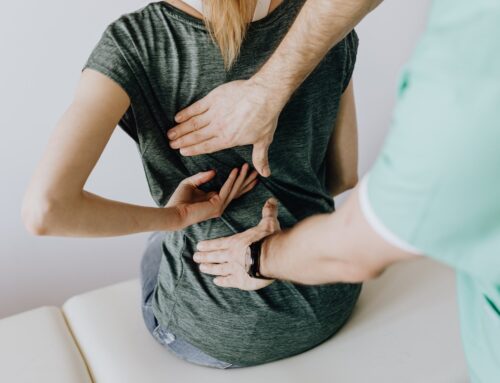With their complex network of bones, tendons and muscles, your shoulders are much more than just a way to scratch an itch. In fact, these powerful body parts collaborate together for incredible movement – from playing catch with the kids to nailin’ that optimal pitch!
But mobility comes at a large cost. It could result in your shoulder’s bone structures or soft tissue becoming more unstable or impinged, which would cause pain–at which a shoulder pain chiropractor can help.
You may consequently feel discomfort all the time or only when moving your shoulder. The soreness might only last a short while, or it might last longer and necessitate medical attention and chiropractic care for shoulder pain.
Anatomy
Three bones make up your shoulder: the collarbone, the shoulder blade, and the upper arm bone (humerus) (clavicle).
Your shoulder blade’s spherical socket receives the upper arm bone’s head. The glenoid is the name of this socket. A network of muscles and tendons maintains your arm bone in the middle of your shoulder socket. The rotator cuff refers to these tissues. They enclose the upper arm bone’s head and join it to the shoulder blade.
Rotator Cuff Tear
The most common shoulder problem is a rotator cuff tear. This happens when one or more of the four tendons that make up your rotator cuff are torn or damaged due to strain from overuse as well as from injuries like falls or accidents. Symptoms may include shoulder pain and weakness, especially when lifting or rotating the arm.
Treatment for a rotator cuff tear often includes physical therapy and sometimes surgery, depending on the severity of the injury. Other shoulder problems can consist of the following:
- bursitis (inflammation of the fluid-filled sacs around your shoulder joints)
- frozen shoulder (stiffness in your shoulder joint)
- dislocation (when one of your bones slips out of its normal position)
- impingement syndrome (pressure on your rotator cuff when it becomes trapped between your shoulder blade and upper arm bone).
Bursitis
Small sacs filled with fluid called bursae are found in all of the body’s joints, including the shoulder. They serve as a cushion between the soft tissues that cover bones and reduce friction between sliding muscles and bones.
Sometimes, heavy use of the shoulder leads to inflammation and swelling of the bursa between the rotator cuff and the region of the shoulder blade, known as the acromion. Subacromial bursitis, a condition, is what happens as a result.
In many cases, bursitis and rotator cuff tendonitis coexist. The many tissues of the shoulder can swell and hurt. It could become challenging to do several daily tasks, such as combing your hair or getting dressed.
Tendinitis
The four rotator cuff muscles are connected to the humerus by their tendons. Overusing your shoulder can lead to inflamed or torn tendons, a problem known as tendinitis.
Tendinitis is most commonly caused by repetitive shoulder motions, such as repeatedly throwing a ball or lifting something above your head. You may have pain with movement and feel tenderness in the affected region.
In addition, your shoulder might become stiff over time and could even lock up, making it difficult to move your arm in specific directions. Resting the joint and physical therapy are often recommended treatments for tendonitis. In some cases, steroid injections and surgery may be necessary if other methods fail to provide relief.
Impingement Syndrome
Impingement syndrome occurs when the muscles and tendons in your shoulder become trapped between your shoulder blade and upper arm bone. This can cause pain, swelling, stiffness, and difficulty moving the joint. It is most commonly caused by an injury or repetitive shoulder motions like throwing or lifting weights above your head.
If left untreated, impingement syndrome can lead to rotator cuff tears, so it is best to seek medical attention from a chiropractor if you suspect you are suffering from this condition. Treatment often includes rest and physical therapy exercises to improve flexibility and reduce inflammation, as well as steroid injections or surgery if necessary.
Instability
When the upper arm bone head is pushed out of the shoulder socket, shoulder instability results and a sudden injury or overuse may be the cause of this.
Partial shoulder dislocations can occur when the upper arm’s ball only partially leaves the socket. An example of this is subluxation. A full dislocation occurs when the ball completely exits the socket.
Dislocations can repeatedly happen once the muscles, tendons, and ligaments surrounding the shoulder weaken or are damaged. Recurrent dislocations, which can be partial or full, make it painful to elevate or move your arm away from your body—an elevated risk of developing joint arthritis results from recurrent subluxations or dislocations.
Arthritis
Arthritis can also cause shoulder pain. Arthritis comes in a variety of forms. However, osteoarthritis, commonly referred to as “wear and tear” arthritis, is the most prevalent type of arthritis in the shoulder. Swelling, discomfort, and stiffness are common early symptoms in middle age. Osteoarthritis takes years to develop, and as it does, the pain it causes gets greater.
Osteoarthritis may be brought on by repetitive stress injuries at work or in sports. In addition, rotator cuff tears, infections, or an inflammation of the joint lining can all be associated with other kinds of arthritis.
People frequently avoid shoulder motions to reduce the pain associated with arthritis. However, this can occasionally cause the soft tissue components of the joint to tighten or stiffen, causing a painful restriction of mobility.
Fracture
A traumatic injury, such as a fall or motor vehicle accident, can cause shoulder fractures. You may hear cracking or grinding when you move your arm after an injury. Fracture pain is usually distinctive and constant.
The treatment for a fracture depends on its severity. Surgical repair may be needed if there are multiple broken pieces. You will likely need to wear a sling while healing, and physical therapy exercises may be recommended to increase your shoulder’s strength and range of motion once healed.
We specialize in treating shoulder pain at Peak Potential Family Chiropractic in Houston Heights, TX. We are dedicated to helping you find relief from the various causes of shoulder pain and restoring your full range of motion so you can get back to doing the things you love.
Contact us today for more information or to schedule an appointment!



